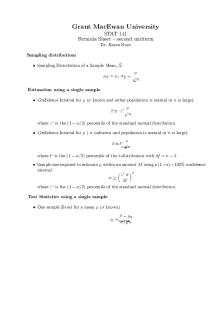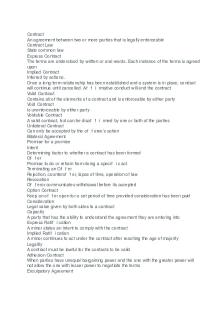Organogenesis - Lecture notes 2 PDF

| Title | Organogenesis - Lecture notes 2 |
|---|---|
| Author | Alisha Khan |
| Course | Introductory Biochemistry |
| Institution | University of Bradford |
| Pages | 2 |
| File Size | 56.2 KB |
| File Type | |
| Total Downloads | 35 |
| Total Views | 130 |
Summary
biochem...
Description
Organogenesis • The formation and development of organs in an animal (or plant) • Organogenesis takes place in the embryo • Completion of organogenesis => fetal stage Embryo development and organogenesis involve a number of processes • Pattern formation • Positional information specification • Induction • Morphogenesis • Cellular differentiation
There Are three Major Classes of Cell-Surface Receptor Proteins -
Ion-channel coupled receptors G-protein- coupled receptors Enzyme-coupled receptors
Activated Receptor Tyrosine Kinases (RTKs) Phosphorylate Themselves
Organogenesis: -
Cell proliferation Cell specialization Cell interaction Cell movement
Morphogens Are Long-Range Inductive Signals That Exert Graded Effects
Lateral Inhibition Can Generate Patterns of Different Cell Types
Asymmetric progression
Repositioning of cells The cells that express Twist move into the interior of the embryo to form mesoderm. Cell Specification The human body comprises approximately 200 distinct cell types with unique molecular and function characteristics . • These are generated during embryogenesis. Process is tightly regulated • Cellular and regional changes in embryonic development following predefined pattern. • Processes manifest as folds, splits condensation • Evolutionary conservation of biological processes • Organ development from endoderm, mesoderm, ectoderm in 3rd to 8th week in utero. • Controlled by intrinsic and extrinsic factors.
Cell specification and determination Two different cell fates: • Determined fate = irreversible. • Committed cells, tendency to developmental path but still able to change fate with sufficient stimulus There are two main types of specification: • Autonomously specified cells develop into a specific fate based upon cytoplasmic determinants with no regard to the cell’s environment (intrinsic). • Conditionally specified cells develop into a specific fate based upon other surrounding cells or morphogen gradients (extrinsic)....
Similar Free PDFs

Organogenesis - Lecture notes 2
- 2 Pages

ORGANOGENESIS
- 52 Pages

ORGANOGENESIS PADA MANUSIA.docx
- 15 Pages

Lecture notes, lecture 2
- 3 Pages

2 - Lecture notes 2
- 5 Pages

Resumen de Organogenesis
- 6 Pages

PPT FIX ORGANOGENESIS DASAR pptx
- 48 Pages

Lecture notes, lecture Chapter 2
- 11 Pages

Lecture notes, lecture formula 2
- 1 Pages

2 Biodiversity - Lecture notes 2
- 33 Pages

Chapter 2 - Lecture notes 2
- 30 Pages

Blaw 2 - Lecture notes 2
- 4 Pages
Popular Institutions
- Tinajero National High School - Annex
- Politeknik Caltex Riau
- Yokohama City University
- SGT University
- University of Al-Qadisiyah
- Divine Word College of Vigan
- Techniek College Rotterdam
- Universidade de Santiago
- Universiti Teknologi MARA Cawangan Johor Kampus Pasir Gudang
- Poltekkes Kemenkes Yogyakarta
- Baguio City National High School
- Colegio san marcos
- preparatoria uno
- Centro de Bachillerato Tecnológico Industrial y de Servicios No. 107
- Dalian Maritime University
- Quang Trung Secondary School
- Colegio Tecnológico en Informática
- Corporación Regional de Educación Superior
- Grupo CEDVA
- Dar Al Uloom University
- Centro de Estudios Preuniversitarios de la Universidad Nacional de Ingeniería
- 上智大学
- Aakash International School, Nuna Majara
- San Felipe Neri Catholic School
- Kang Chiao International School - New Taipei City
- Misamis Occidental National High School
- Institución Educativa Escuela Normal Juan Ladrilleros
- Kolehiyo ng Pantukan
- Batanes State College
- Instituto Continental
- Sekolah Menengah Kejuruan Kesehatan Kaltara (Tarakan)
- Colegio de La Inmaculada Concepcion - Cebu



